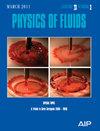具有对称波纹壁的纳米通道中由流势诱导的电动流和能量转换
IF 4.1
2区 工程技术
Q1 MECHANICS
引用次数: 0
摘要
对带电对称波纹表面纳米通道中的电动力流进行了理论和数值研究。给出了电动力流变量的扰动和数值解,并系统研究了波纹的几何形状(如波幅和波数)对电动力流特性的影响。结果表明,由于电粘性效应,电动力流在波峰处很容易发生再循环。速度剖面与波数密切相关,但最大或最小速度可能不受波数影响。此外,我们还研究了流势和能量转换效率的分布。我们发现,对于一些特殊的波纹几何形状,本波纹纳米通道获得的流势和能量转换效率均高于光滑纳米通道。特别是当无量纲波数为 0.5/π 时,δ = 0.5 时的流势大小提高了约 29%,δ = 0.1 时的转换效率峰值提高了约 2%。我们相信,最佳的波纹几何参数有助于设计出具有更高流电势和转换效率的微流体装置。本文章由计算机程序翻译,如有差异,请以英文原文为准。
Electrokinetic flow and energy conversion induced by streaming potential in nanochannels with symmetric corrugated walls
A theoretical and numerical investigation of electrokinetic flow is performed in a nanochannel with the charged symmetric corrugated surfaces. The perturbation and numerical solutions of electrokinetic flow variables are given, and the effects of corrugation geometry, such as wave amplitude and wave number, on the electrokinetic flow characteristics are systematically examined. The results show that the electrokinetic flow recirculation may occur easily at wave crest due to the electroviscous effect. The velocity profile is strongly dependent on wave number, but the maximum or minimum velocity may be insusceptible to wave number. Furthermore, the distributions of streaming potential and energy conversion efficiency are also investigated. We find that, for some special geometry of corrugations, the streaming current and conversion efficiency obtained from the present corrugated nanochannel are higher than that from the smooth nanochannel. Specially, when the dimensionless wave number is 0.5/π, the magnitude of streaming potential is enhanced about 29% at δ = 0.5 and the peak value of conversion efficiency is enhanced about 2% at δ = 0.1. We believe that the optimal corrugation geometry parameters can be of benefit in designing a microfluidic device with higher streaming current and conversion efficiency.
求助全文
通过发布文献求助,成功后即可免费获取论文全文。
去求助
来源期刊

Physics of Fluids
物理-力学
CiteScore
6.50
自引率
41.30%
发文量
2063
审稿时长
2.6 months
期刊介绍:
Physics of Fluids (PoF) is a preeminent journal devoted to publishing original theoretical, computational, and experimental contributions to the understanding of the dynamics of gases, liquids, and complex or multiphase fluids. Topics published in PoF are diverse and reflect the most important subjects in fluid dynamics, including, but not limited to:
-Acoustics
-Aerospace and aeronautical flow
-Astrophysical flow
-Biofluid mechanics
-Cavitation and cavitating flows
-Combustion flows
-Complex fluids
-Compressible flow
-Computational fluid dynamics
-Contact lines
-Continuum mechanics
-Convection
-Cryogenic flow
-Droplets
-Electrical and magnetic effects in fluid flow
-Foam, bubble, and film mechanics
-Flow control
-Flow instability and transition
-Flow orientation and anisotropy
-Flows with other transport phenomena
-Flows with complex boundary conditions
-Flow visualization
-Fluid mechanics
-Fluid physical properties
-Fluid–structure interactions
-Free surface flows
-Geophysical flow
-Interfacial flow
-Knudsen flow
-Laminar flow
-Liquid crystals
-Mathematics of fluids
-Micro- and nanofluid mechanics
-Mixing
-Molecular theory
-Nanofluidics
-Particulate, multiphase, and granular flow
-Processing flows
-Relativistic fluid mechanics
-Rotating flows
-Shock wave phenomena
-Soft matter
-Stratified flows
-Supercritical fluids
-Superfluidity
-Thermodynamics of flow systems
-Transonic flow
-Turbulent flow
-Viscous and non-Newtonian flow
-Viscoelasticity
-Vortex dynamics
-Waves
 求助内容:
求助内容: 应助结果提醒方式:
应助结果提醒方式:


